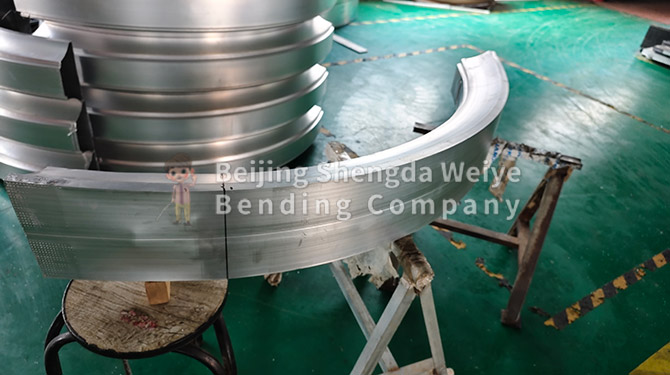Optimizing the industrial stretch bending process: Strategies for enhancing efficiency and reducing waste
The industrial stretch bending process is a crucial manufacturing technique used to shape materials—primarily metals—into desired forms for various applications, including automotive, aerospace, and construction. As industries strive for greater efficiency and sustainability, optimizing the stretch bending process has become imperative. This article explores effective strategies to enhance efficiency and minimize waste in the stretch bending process.
Stretch bending involves applying tensile forces to elongate a material while simultaneously bending it to achieve specific geometries. The process is characterized by its ability to produce complex shapes with high precision, making it invaluable in industries where exact specifications are critical. However, inefficiencies and waste can arise due to various factors, including equipment limitations, material handling, and process management.
Strategies for Enhancing Efficiency
1.Investing in Advanced Technologies
-Automation: The integration of automated systems can significantly enhance the efficiency of the stretch bending process. Automated machines can perform repetitive tasks with high precision and speed, reducing cycle times and human errors. Additionally, robotic arms can handle material loading and unloading, minimizing downtime.
-Smart Sensors and IoT: Implementing smart sensors and IoT (Internet of Things) devices can provide real-time monitoring of the bending process. These technologies can analyze parameters such as temperature, pressure, and material strain, allowing for immediate adjustments to optimize performance.
2.Material Selection and Preparation
-Choosing the Right Materials: Selecting appropriate materials with optimal mechanical properties is essential. High-strength, lightweight materials can reduce the amount of force required during bending, leading to less energy consumption and lower wear on machinery.
-Pre-Processing the Material: Proper material preparation, including cleaning and surface treatment, can improve the bending process's effectiveness. Ensuring that materials are free from contaminants can reduce the risk of defects and enhance the overall quality of the final product.
3.Process Optimization
-Bend Sequence and Angle: Carefully planning the bend sequence and angles can minimize stress concentrations and improve the overall efficiency of the bending process. Using simulation software to model the bending process can help identify the optimal parameters before actual production.
-Cycle Time Reduction: Analyzing each step of the bending process to identify bottlenecks can lead to cycle time reductions. Streamlining operations, such as reducing the time spent on adjustments between bends, can optimize throughput.
4.Training and Workforce Development
-Skilled Labor: Investing in workforce training programs ensures that operators are well-versed in the latest techniques and technologies related to stretch bending. A skilled workforce can identify issues early, perform maintenance, and operate equipment more efficiently.
-Cross-Training Employees: Encouraging cross-training among employees can provide flexibility in labor allocation. This strategy ensures that operations can continue smoothly even if key personnel are unavailable.

Strategies for Reducing Waste
1.Lean Manufacturing Principles
-Implementing Lean Practices: Adopting lean manufacturing principles can help identify and eliminate waste throughout the stretch bending process. Techniques such as 5S (Sort, Set in order, Shine, Standardize, Sustain) can create a more organized and efficient workspace.
-Value Stream Mapping: Conducting value stream mapping to visualize the entire production process can help pinpoint areas of waste and inefficiency. By understanding the flow of materials and information, companies can make informed decisions to streamline operations.
2.Recycling and Reusing Materials
-Material Recovery: Establishing systems for recovering and reusing scrap materials generated during the stretch bending process can significantly reduce waste. By recycling cut-offs and other remnants, companies can lower material costs and contribute to sustainability efforts.
-Design for Manufacturability (DFM): Incorporating DFM principles during the design phase can reduce the amount of material needed and minimize waste. Designing parts with fewer complexities can also simplify the bending process, leading to less scrap.
3.Continuous Improvement Programs
-Kaizen Initiatives: Implementing continuous improvement initiatives, such as Kaizen, fosters a culture of ongoing evaluation and enhancement. Encouraging employees to contribute ideas for waste reduction and efficiency improvement can lead to innovative solutions and a more engaged workforce.
-Regular Audits and Feedback Loops: Conducting regular audits of the stretch bending process and establishing feedback loops can help identify inefficiencies and areas for improvement. Utilizing data analytics to track performance metrics can provide insights into trends and potential issues.
Optimizing the industrial stretch bending process is essential for enhancing efficiency and reducing waste. By investing in advanced technologies, improving material selection, optimizing processes, and fostering a skilled workforce, companies can achieve significant gains in productivity and sustainability. Adopting lean manufacturing principles and committing to continuous improvement will not only benefit the bottom line but also contribute to a more environmentally responsible manufacturing sector. As industries continue to evolve, the emphasis on efficiency and waste reduction will remain a keyfocus in the quest for operational excellence.
20
2025-08
Number of visitors:1
HOT NEWS
-
Selection and Maintenance Strategies for Aluminum Bending Equipment
2025-12-27
-
Reducing the rebound error of car bumper bending enhances the stability of mass production.
2025-12-17
-
High-precision bending processing service: Automated bending process
2025-12-08
-
High-Accuracy Curve Forming: Achieving Consistent Bends in Aluminum, Steel, and Alloy Materials
2025-11-27




 English
English Chinese
Chinese Japan
Japan German
German

 LIST
LIST
